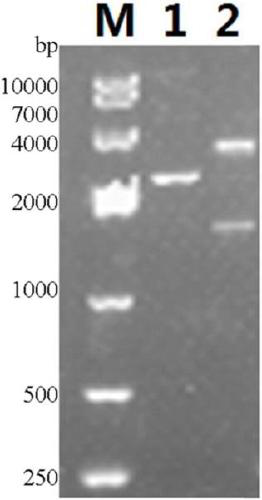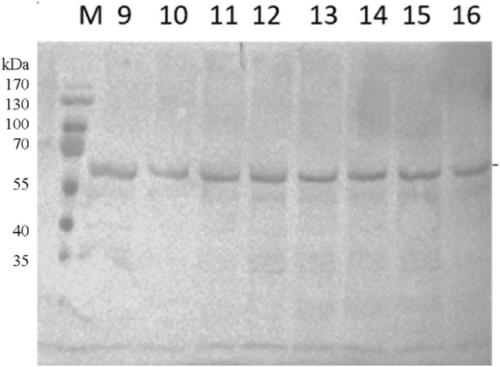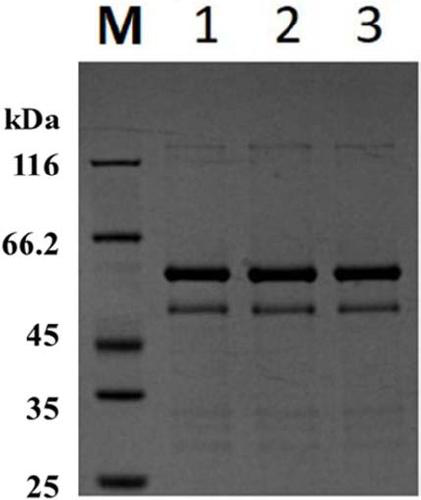Expression of recombinant human papilloma virus 52 subtype protein
A technology of human papillomavirus and human papilloma, applied in the field of production of recombinant human papillomavirus 52 subtype virus-like particles, can solve the problems of low expression level and no expression, achieve high expression level, easy operation, and benefit large scale The effect of large-scale industrial production
- Summary
- Abstract
- Description
- Claims
- Application Information
AI Technical Summary
Problems solved by technology
Method used
Image
Examples
Embodiment 1
[0050] Example 1: HPV52L1 codon optimization design
[0051] The full-length HPV 52L1 has a total of 529 amino acid sequences, similar to other genes of the HPV L1 family, and also has two translation initiation sites, corresponding to full-length HPV 52L1 (529 amino acids) and HPV 52L1 (503 amino acids), respectively. Analysis of the first 27 amino acids of full-length HPV52L1, most of which are hydrophobic amino acids, are more likely to be transmembrane regions, which will have a certain impact on expression. Early HPV 16L1 expression studies showed that HPV 16L1 (505 amino acids) could form VLPs in various expression systems, while no VLP formation was observed for full-length HPV 16L1 (531 amino acids). Therefore, it is speculated that the two translation initiation points of high-risk HPV L1 may be related to the pathological process of cervical cancer. During the final virus assembly process, a 505 amino acid L1 coat protein is expressed (Virus Genes. 2005; 30(1):31-35...
Embodiment 2
[0055] Embodiment 2: Construction of HPV52L1 recombinant expression vector
[0056] The synthesized 52L1 sequence was cloned into pPICZalphaB vector by the following method. The 52L1 DNA fragment with BstBI and KpnI at both ends was amplified by PCR, PCR primer: forward primer: 5'CAGGTGATCTTCGAAACGATGTCCGTTTGGAGAC3'(BstBI) (SEQ ID NO: 4); reverse primer: 5'ATTGGTACCCTATTATCTCTTGACT 3' (KpnI) (SEQ ID NO: 5). PCR program: cycle 30 times at 94°C for 5 minutes, 94°C for 30 seconds, 55°C for 30 seconds, 72°C for 1 minute and 50 seconds, 72°C for 10 minutes, 10°C for 10 minutes, and the operation ends. The PCR product was identified by agarose gel electrophoresis and the band at 1500bp was recovered (Qiagen gel extraction kit). The recovered fragments were digested with pPICZalphaB with BstBI and KpnI (New England Biolab), identified by agarose gel electrophoresis, and about 1500bp and 3600bp fragments were recovered respectively. After recovery, 52L1 and pPICZalphaB were ligated...
Embodiment 3
[0057] Example 3: Construction and expression of HPV52L1 recombinant expression strain
[0058] Linearize pPICZ52L1 with SacI. After the enzyme digestion reaction, remove the protein with phenol: chloroform, add 2.5 times the volume of absolute ethanol, and precipitate DNA with 1 / 10 volume of 3M NaAc (pH5.2). The resulting precipitate is washed with 75% ethanol and dried. ddH 2 O dissolved the precipitate, electroporated Pichia host bacteria, spread it on a YPDS plate (containing 180 μg / mL Zeocin), and cultured at 30°C for 3 days to obtain hundreds of clones. Dozens of clones were picked and inoculated on YPD plates (containing 1500 μg / mL Zeocin), screened for high-copy plasmid strains, and cultured at 30°C for 2 days. Some clones grew faster, and several clones with the best growth conditions were picked and inoculated in 5mL YPD liquid medium. After 24 hours, the BMMY medium was replaced, and the bacteria were collected after 48 hours of induction with 0.5% methanol. After...
PUM
| Property | Measurement | Unit |
|---|---|---|
| molecular weight | aaaaa | aaaaa |
| diameter | aaaaa | aaaaa |
Abstract
Description
Claims
Application Information
 Login to View More
Login to View More - R&D
- Intellectual Property
- Life Sciences
- Materials
- Tech Scout
- Unparalleled Data Quality
- Higher Quality Content
- 60% Fewer Hallucinations
Browse by: Latest US Patents, China's latest patents, Technical Efficacy Thesaurus, Application Domain, Technology Topic, Popular Technical Reports.
© 2025 PatSnap. All rights reserved.Legal|Privacy policy|Modern Slavery Act Transparency Statement|Sitemap|About US| Contact US: help@patsnap.com



